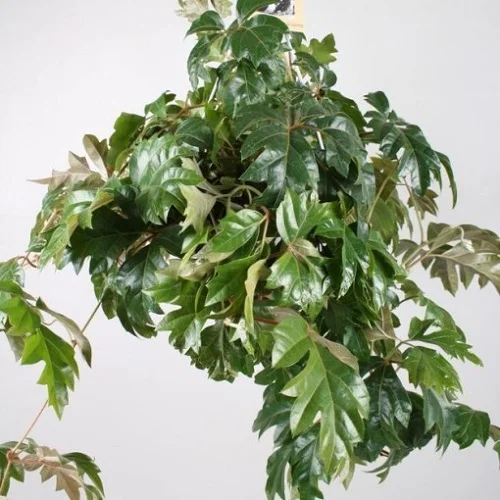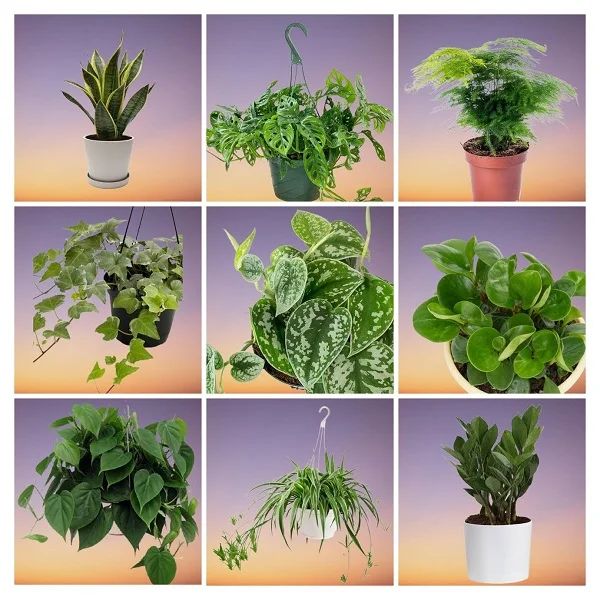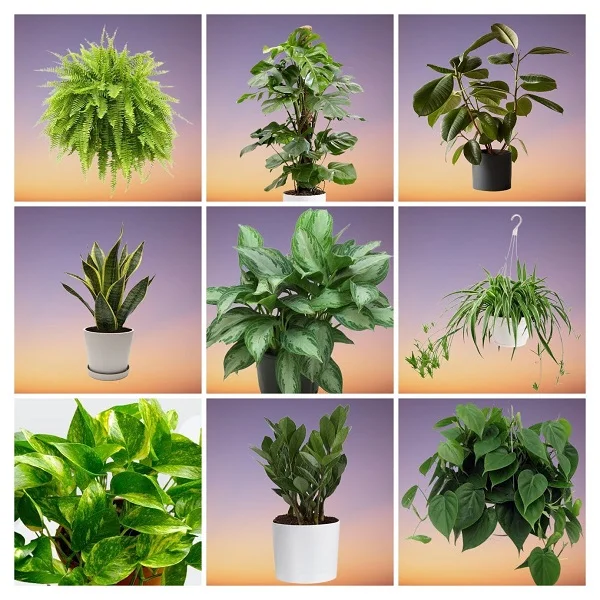How to Grow and Care for Grape Ivy Plant (Cissus rhombifolia) Indoors
Some links in this post may be affiliate links
Grape Ivy (Cissus rhombifolia) blossoms in bright light away from direct sunlight, average warmth, moderate humidity and moderately moist, well drained soil coupled with monthly feeding in the growing season.
Grape Ivy Plant is a beautiful, low-maintenance trailing plant to add some greenery to your home. In this guide, you will learn everything about caring for Grape Ivy indoors, including: ideal lighting, watering schedules, humidity, propagation and common plant problems.
Cissus rhombifolia also called Oakleaf Ivy or Venezuela Treebine is one of the most tolerant of plants which will tolerate sun or shade, hot or cold air, dry or moist conditions.
Each leaf is made up of 3 leaflets, silvery at first and dark green and glossy when mature. Oakleaf Ivy bears tendrils by which it clings to supports.
As with all vines, Grape Ivy Houseplant can be used for clothing bare surfaces, for a hanging basket, as a climber on a pole or trellis or as a ground cover.
Like the fast-growing Tolmiea menziesii (Piggyback Plant ), Cissus rhombifolia is one of the best plants for a hanging basket.

Botanical name: Cissus rhombifolia
synonym: Cissus alata
Family: Vitaceae
Common names: Grape Ivy, Grape Ivy Plant, Grape Ivy Houseplant, Oakleaf Ivy, Venezuela Treebine
Origin
Cissus rhombifolia also called Cissus alata is native to the New World Tropics, from Mexico to Bolivia, and Venezuela, Trinidad and Guyana.
Is Grape Ivy pet-friendly?
Grape Ivy is non-toxic to both humans and pets according to ASPCA.
Varieties
Several varieties of Grape Ivy are available for indoor growing.
- Ellen Danica (Mermaid Vine) has lobed leaflets.
- Jubilee has large dark green leaflets.
- Cape Grape (Evergreen Grape Vine) bears leaves which are undivided whose surface is glossy and brown-edged, the underside is brown and flurry.
What are the benefits of Grape Ivy?
- Low maintenance: Requires minimal watering once established.
- Versatile: Perfect for hanging baskets, trellises, or shelves.
- Fast-growing: Grows rapidly to fill any space.
- Unique foliage: Adds aesthetic value to any space.
- Pet-safe: It is non-toxic to cats and dogs
- Tolerant: Withstands indoor conditions very well.
How to take care of Grape Ivy Plant indoors
Now, let’s explore how to keep your Grape Ivy thriving indoors to bring an elegant and calming presence to any indoor space.
Grape Ivy thrives in bright light away from direct sunlight, average warmth of 18-270C, moderate humidity of 50-55% and moderately moist, well drained, all purpose soil coupled with monthly feeding during the growing season.
Cissus rhombifolia care requires regular pruning to keep it neat, to reduce pest infestations, to encourage a compact growth and to rejuvenate growth. Repotting is done every two years at the beginning of the growing season. Keep reading for more on these growing conditions and how to provide them.

Watering
Water Grape Ivy thoroughly during the growing season while allowing the top 2 inches of soil to dry a little between waterings. Overwatering may result in yellowing leaves and mushy stems.
Decrease watering in the cold season as growth is minimal at this time to maintain the soil slightly moist. Do not let the soil dry out completely to avoid wilting and dry leaf tips.
Make sure that the pot has a drainage hole to prevent the soil from getting soggy as it can lead to rotting and death of the plant.
Light Requirements
Grape Ivy thrives in bright indirect light. Though it can tolerate some shade, it will grow much slower.
If the light is too little, Cissus rhombifolia may stop growing or become leggy with sparsely-spaced pale leaves. In such a case, move it to a brighter location or use a grow light if the natural lighting is not adequate.
Keep Oakleaf Ivy away from direct sunlight as it can cause wilting and scorching of the leaves.
Pro-tip: Rotate the pot regularly to ensure that the plant receives adequate light on all sides for even growth.
Temperature and Humidity
Cissus rhombifolia grows best in average warmth of 18-270C with a minimum of 150C. Though it can adapt to a wide range of temperatures, constantly high temperatures can damage the plant.
Grape Ivy has no need for extra humidity, average humidity of 50-55% is sufficient for the plant. However, for lush growth and to reduce pest infestation, it needs more humidity.
Therefore, to increase humidity set the pot on a wet pebble tray, use a humidifier or group the plants together. You may also grow the plant in a well-lit bathroom, kitchen, and other moist areas in the home.
Pro tip: Ensure there is good air flow to minimize fungal diseases.
Potting Medium
The best soil for Grape Ivy should be a well-draining, nutrient-rich soil mix. A mix made up of 1 part potting soil, 1 part perlite or sand and 1 part peat moss or coconut coir is ideal for this plant.
Feeding
Feed Grape Ivy every 3-4 weeks during the growing season with a balanced, liquid fertilizer for a lush growth. Stop feeding in the cold season (fall and winter) as growth is minimal at this time. Avoid too much fertilizer as it can cause weak, leggy growth.
Repotting
Repot Oakleaf Ivy every 2 years during the growing period. Use a pot that is 1 size larger and ensure that the pot has a drainage hole to prevent the soil from getting soggy to avoid rotting and eventual death of the plant. Check out these ceramic pots available on Amazon.
Pruning & Grooming
Pruning Cissus rhombifolia involves:
- Removal of yellow and dead leaves to maintain the plant neat and minimize pest and disease infestations.
- Pinching off the growing tips to encourage a bushy and compact growth; the tips can be used to propagate new plants.
- Cutting back the leggy stems to rejuvenate growth.
- Regularly cleaning the leaves under a stream of running water to get rid of dust and to discourage pest infestation.
Pro tip: Pruning in spring promotes faster, healthier growth.
Grape Ivy Propagation
Grape Ivy (Cissus rhombifolia) is propagated at the beginning of the growing season from stem cuttings or by spreading the stems on the soil.
(A) How to propagate Grape Ivy from stem cuttings
The cuttings root easily so there is no need for a rooting hormone. They can be rooted in soil or in water.
1. Propagating Grape Ivy from stem cuttings in soil
- Take stem cuttings of about 4-5 inches length from a healthy plant. Ensure the cutting has 2-3 leaf nodes.
- Allow the sap from the cut end to dry out for 1-2 days to prevent rotting.
- Fill small pots (about 6-8 inches wide) with a well-drained, rooting soil and moisten it lightly.
- Insert 1-2 inches of the cuttings in the moist rooting soil.
- Place the set up in a warm, well-lit place away from direct sunlight.
- Maintain the soil moist until new growth emerges from the cuttings. Roots should develop within 2-4 weeks.
- Once you observe substantial growth, transfer the new plants into one size larger pots in well-drained soil and begin routine care.
2. Propagating Grape Ivy from stem cuttings in water
- Take 4-5 inches stem cuttings from a healthy plant. Make sure that each of the cuttings has 2-3 leaf nodes.
- Allow the sap from the cut end to dry out (callous) for 1-2 days to prevent rotting.
- Place the cuttings in a jar of plain water or in a propagation station.
- Position the set up in a brightly-lit spot away from direct sunlight and change the water every 5-7 days.
- When the roots are about 2-3 inches, transfer the rooted cuttings into individual pots in moist, well-drained soil.
- Keep the soil slightly moist until the new plants are well established after which you can begin routine care.
Pro tip: For a fuller plant, transplant several cuttings into one pot.
(B) How to propagate Grape Ivy by spreading the stems on the soil
This method of propagation is much faster and results in more stronger, healthier plants than stem cutting propagation.
3. Propagating Grape Ivy by spreading the stems on the soil
- Spread the stems on the soil surface while still attached to the mother plant.
- The stems will root at every point that they come into contact with the soil.
- Once rooted, sever the stems from the mother plant, dig them up and pot them in moist soil in individual pots.
- Place the pots in a warm, well-lit place away from direct sunlight to avoid scorching.
- Maintain the soil moist until the new plants are well established after which you can begin routine care.

Cissus rhombifolia Problems & Solutions
Grape Ivy (Cissus rhombifolia) common problems are pests, wilting rotting and leaf drop, brown leaf tips and shrivelled leaves, leaf spots, curled leaves, leggy growth, yellow leaves, and diseases among others. Keep reading for more on these problems and how to solve them.
Pests
Grape Ivy is prone to mealybugs infestations. Isolate the affected plant to prevent spread to other houseplants and treat it with horticultural oil as recommended by the manufacturer.
Wilting, rotting and leaf drop
Wilting, rotting and leaf drop in Grape Ivy are caused by root-rot which is prevalent in soggy soil.
- Carefully, slip the plant out of its pot, wash off the soil from the roots and inspect them.
- Cut away brown-black, mushy roots and treat the healthy ones with a fungicidal solution.
- Clean and disinfect the pot with the fungicidal solution and repot the plant in fresh soil. Keep it dry for a few days before beginning the regular watering.
- In future, ensure that the soil is loose, well-draining and that the pot has a drainage hole.
- Always allow the soil to dry out slightly between waterings.
Brown leaf tips and shrivelled leaves
Brown leaf tips and shrivelled leaves on Grape Ivy are due to dry air. Set pot on a wet pebble tray or use a cool mist humidifier to raise humidity.
Mildew on leaves
Mildew on the leaves of Grape Ivy Plant is an indication of powdery mildew which is promoted by soggy soil. Remove the diseased leaves and avoid wetting the remaining leaves. Repot the plant in fresh soil in a new pot which has adequate drainage. Improve air circulation.
Slow growth and yellowish leaves
Slow growth and yellowish leaves in Grape Ivy are caused by underfeeding. Feed every 3-4 weeks during the growing season (spring and summer) with a balanced, liquid fertilizer. Do not feed in the cold season (fall and winter) to avoid fertilizer burn.
Leggy growth and undersized new leaves
Leggy growth and undersized new leaves in Grape Ivy Plant are due to low light. Move the plant to a brighter spot or instal a grow light if the natural light is not adequate.
Wilting of leaves
One possible cause of wilting leaves on Grape Ivy is too cold temperatures. Move the plant to a warmer place and protect it from cold drafts.
If wilting of leaves is accompanied by leaf fall, the possible causes are underwatering and too much sunlight.
Keep the soil moderately moist during the growing season and slightly moist in the cold season. Never allow the soil to dry out completely. Position the plant to a shadier place.
Spotted and curled leaves
Spotted and curled leaves in Grape Ivy are caused by underwatering Water when the top 2-3 inches of soil dry out and do not allow the soil to dry out completely
Glassy blotches and leaf drop
Glassy blotches and leaf drop in Grape Ivy is caused by exposure to hot direct sunshine. Keep the plant away from direct sunlight or instal a light curtain to filter the light.
Conclusion
Grape Ivy (Cissus Rhombifolia) is a hardy, adaptable vine that thrives indoors with minimal effort. Whether you want it to trail elegantly from a hanging basket or climb a trellis, this plant is a versatile, low-maintenance choice for any home.
You liked it? Share on social media.
Related Content
Amazon Associates Disclosure
Homeplantsguide.com is a participant in the Amazon Services LLC Associates Program, an affiliate advertising program designed to provide a means for sites to earn advertising fees by advertising and linking to amazon.com.





